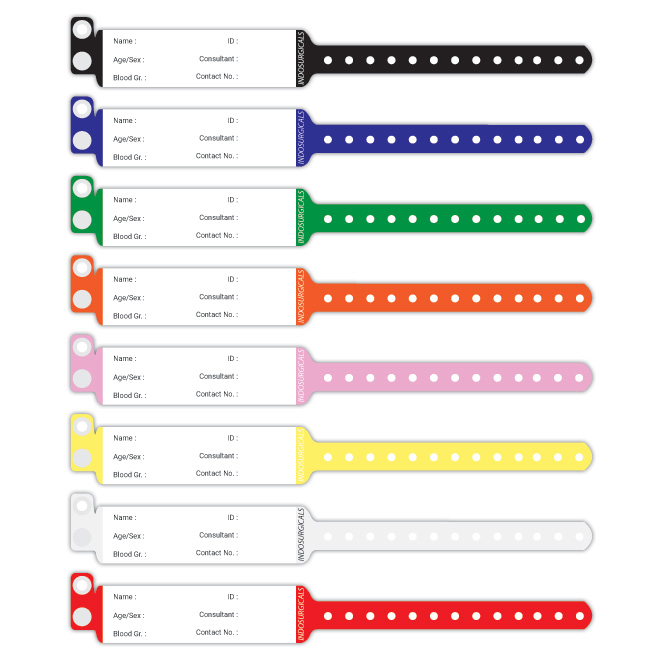Why Investing in a High-Quality Patient Identification Band is Crucial for Medical Institutions
Checking Out the Various Kinds Of Patient Identification Band Made Use Of in Medical Facilities
In the intricate world of medical care, the important duty of Patient Identification bands usually goes unnoticed. These bands, differing from simple paper wristbands to sophisticated RFID bands, create the foundation of Patient security methods, guaranteeing accuracy in Patient Identification.
Understanding the Value of Patient Identification Bands
While they may seem like plain accessories, Patient Identification bands play a crucial function in medical centers. These bands offer as a vital device for verifying Patient identity, preventing clinical mistakes associated to misidentification. Patient Identification bands likewise aid in streamlining management tasks, guaranteeing accurate record-keeping and payment.
Standard Paper Wristbands: Their Usage and Limitations
Traditional paper wristbands have actually been a staple in Patient Identification across various clinical facilities. While their use prevails, they harbor particular restrictions that might affect their effectiveness in Patient administration. This area will concentrate on the extent of their application and the fundamental downsides connected with their use.
Paper Wristbands: Use Scope
In the realm of Patient Identification, paper wristbands have long held an important function. These bands are normally made use of in outpatient setups, where the Patient's keep is temporary. In spite of developments in innovation, the simple paper wristband stays a cost-effective and dependable service for Patient Identification in numerous healthcare circumstances.
Limitations of Paper Wristbands
In spite of their extensive use, paper wristbands are not without their downsides. Their physical longevity is among the significant constraints. Direct exposure to water, sweat, or misuse can render them unreadable and even create them to degenerate. In enhancement, paper wristbands commonly do not have the technological capabilities of even more modern-day options, such as barcoding or RFID chips, limiting their functionality to just presenting composed information. The inability to upgrade or customize the data on the wristband is an additional drawback. If the information is transcribed, clarity can be compromised, leading to possible misidentification. Paper wristbands can cause pain or skin inflammation to some patients, particularly when worn for extensive periods.
Barcoded Wristbands: Developments in Patient Identification
While Patient Identification has actually long been an essential facet of healthcare, the introduction of barcoded wristbands represents a significant jump onward. These bands leverage the simplicity of barcoding modern technology, enabling for Patient details to be swiftly scanned and accessed. They boost the rate and precision of Patient Identification, minimizing the risk of clinical mistakes associated to misidentification.
Superhigh Frequency Identification (RFID) Bands: a Step In The Direction Of Futuristic Healthcare
The development of Patient Identification bands has caused the development of Radio Regularity Identification (RFID) Bands (patient identification band). These ingenious gadgets present vital benefits for health care facilities, offering an extra effective and technologically progressed methods of Patient Identification. The application of RFID in health care is a significant step towards an extra futuristic approach to Patient administration and safety
Recognizing RFID Bands
)
RFID Bands: Key Benefits
Largely, these bands improve Patient safety and security by offering exact, instantaneous Identification, consequently reducing clinical mistakes. RFID bands can store a substantial quantity of Patient data, consisting of medical background and allergic reactions, allowing customized treatment. In general, RFID bands stand for a significant improvement in Patient Identification modern technology, benefiting both individuals and medical his response care service providers.
Carrying Out RFID in Medical Care
These bands provide a smooth way to track and recognize clients, guaranteeing their security and enhancing efficiency in therapy procedures. RFID bands reduce clinical mistakes by offering exact Patient Identification, which is crucial in stopping misdiagnosis or wrong medication management. Thus, the execution of RFID bands is a significant action in the direction of improving Patient safety and security and health care distribution.

Color-Coded Wristbands: Assisting in Quick and Accurate Medical Diagnosis
In the bustling atmosphere of a clinical center, color-coded wristbands have actually emerged as essential tools for swift and specific Identification of an individual's medical condition. These wristbands, used by patients, carry certain shades that correspond to different medical problems or standings. This system is created to supply immediate visual hints to medical care service providers, boosting Patient safety and care quality.
Methods for Reliable Execution and Management of Patient ID Bands
Attaining ideal use of Patient Identification bands demands a well-structured method for their implementation and monitoring. Patient education and learning is likewise essential; people need to understand the objective of the bands and the requirement for their consistent wear. It's vital to have a backup plan in area, such as barcode scanning or biometrics, to guarantee that Patient Identification is never ever compromised.
Final thought
Patient Identification bands are essential in medical centers to ensure safety and security and accuracy. Standard paper, barcoded, RFID, and color-coded wristbands each hold unique advantages, varying from cost-effectiveness to advanced data storage space and instant medical signals. Effective application and management of these bands can considerably lower medical errors, improve efficiency, and enhance general Patient treatment. Thus, understanding and using these Identification devices is paramount for preserving high criteria in healthcare.
These bands, varying from basic paper wristbands to innovative RFID bands, create the foundation of Patient safety and security procedures, ensuring accuracy in Patient Identification.The evolution of Patient Identification bands has brought regarding the introduction of Radio Regularity Identification (RFID) Bands. In general, RFID bands represent a here substantial advancement in Patient Identification modern technology, benefiting both patients and healthcare companies.
RFID bands decrease medical mistakes by giving accurate Patient Identification, which is crucial in preventing misdiagnosis or incorrect medicine management. Patient education is also crucial; patients have to recognize the objective of the bands and the requirement for their continuous wear.